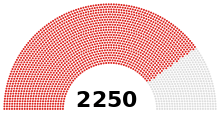Supreme Soviet of the Soviet Union
 |
| This article is part of a series on the politics and government of the Soviet Union |
|
Judiciary |
|
Soviet Union portal |

The Supreme Soviet of the Soviet Union (Russian: Верхо́вный Сове́т СССР, Verkhóvnyj Sovét SSSR) was the highest legislative body in the Soviet Union[1] and the only one with the power to pass constitutional amendments. It elected the Presidium, formed the Council of Ministers and the Supreme Court, and appointed the Procurator General of the Soviet Union.
Structure
The Supreme Soviet was made up of two chambers, each with equal legislative powers, with members elected for four-year terms:[2]
- The Soviet of the Union, elected on the basis of population with one deputy for every 300,000 people in the Soviet federation
- The Soviet of Nationalities, supposed to represent the ethnic populations, with members elected on the basis of 32 deputies from each union republic, 11 from each autonomous republic, five from each autonomous oblast (region), and one from each autonomous okrug (district). The administrative units of the same type would send in the same number of members regardless of their size or population.
Under the Soviet constitutions of 1936 and 1977, the Supreme Soviet was imbued with great lawmaking powers. In practice, however, it functioned as a rubber stamp for decisions already made by the CPSU. This later became common practice in all Communist countries. However, with the advent of Perestroika and the partially free elections in 1989, the Supreme Soviet acquired a greater role in the government.
After 1989 it consisted of 542 deputies (down from previously 1,500). The meetings of the body were also more frequent, from six to eight months a year.[3] The presidium carried out the day-to-day operations of the Supreme Soviet when it was not in session.
Chairmen of the presidium of the Supreme Soviet of the USSR (1938–1989)
- Mikhail Kalinin 1938–1946
- Nikolay Shvernik 1946–1953
- Kliment Voroshilov 1953–1960
- Leonid Brezhnev 1960–1964
- Anastas Mikoyan 1964–1965
- Nikolai Podgorny 1965–1977
- Leonid Brezhnev (second term) 1977–1982
- Yuri Andropov 1982–1984
- Konstantin Chernenko 1984–1985
- Andrey Gromyko 1985–1988
- Mikhail Gorbachev 1 October 1988 – 25 May 1989
Chairmen of the Supreme Soviet of the USSR (1989–1991)
- Mikhail Gorbachev 25 May 1989 – 15 March 1990
- Anatoly Lukyanov 15 March 1990 – 22 August 1991
Convocations
- 1st convocation session 1938 - 1946, World War II
- 2nd convocation session 1946 - 1950
- 3rd convocation session 1950 - 1954
- 4th convocation session 1954 - 1958
- 5th convocation session 1958 - 1962
- 6th convocation session 1962 - 1966
- 7th convocation session 1966 - 1970
- 8th convocation session 1970 - 1974
- 9th convocation session 1974 - 1979
- 10th convocation session 1979 - 1984
- 11th convocation session 1984 - 1989
- 1st convocation 1989 - 1991[4] (unofficially 12th convocation), sessions were conducted in the form of Congress of People's Deputies of the Soviet Union
- New composition 1991,[5] (unofficially 13th convocation) unlike previous convocations, there were no elections for the new composition of the Supreme Council instead members of the council were delegated from the council of union republics that continued to be members of the Soviet Union.
Supreme councils of union and autonomous republics
Beside the Supreme Council, in the Soviet Union also existed supreme councils in each of union and autonomous republics. The supreme councils of republican level also were headed by their presidiums, but all those councils consisted of one chamber. After dissolution of the Soviet Union, some councils of the succeeded independent republics simply changed their name to their historic or to emphasis the importance of the council as a national parliament, while others went through some major restructuring by changing to double chamber assemblies. Please, note that all republics in the Soviet Union were soviet (as soviet national), yet 15 were of union level, while the other, autonomous republics, were subordinated to the union republics.
Supreme councils of union republics
- Supreme Council of Georgia, in 1992 changed its name to State Council of Georgia
- Supreme Council of Russia, until 4 October 1993 when it was dissolved as part of the 1993 Russian constitutional crisis (replaced with the Federal Assembly)
- Supreme Council of Kazakhstan, until 1995 (replaced with the Parliament of Kazakhstan)
- Supreme Council of the Karelo-Finnish Soviet Socialist Republic, in 1940-1956
- Supreme Council of Belarus, until 1996 (replaced with the National Assembly of Belarus)
- Supreme Council of Lithuania, in 1991 changed its name to the Seimas
- Supreme Council of Moldavia, in 1991 changed its name to the Parliament of the Republic of Moldova
- Supreme Council of Azerbaijan, in 1991 changed its name to National Assembly of Azerbaijan (Mill Mejlis Azerbaijan)
- Supreme Council of Ukraine, in 1991 adopted Ukrainian transliterated name Verkhovna Rada (repeating the way previous parliament was named in 1917-1918, Tsentralna Rada)
Supreme councils of autonomous republic
List of known autonomous republics councils
- Supreme Council of the Karelian Autonomous Soviet Socialist Republic, existed in 1938-1994, except for 1940-1956 when Karelian ASSR was a union republic the Karelo-Finnish SSR
- Supreme Council of Crimean Autonomous Soviet Socialist Republic, in 1938-1946 and 1991, transitioned to Verkhovna Rada of Autonomous Republic of Crimea (in Ukraine)
See also
References
- ↑ The Congress of Soviets was the supreme legislative body from 1917 to 1936. In 1989-1991 a smillar. but not identical (elected directly by the people instead of local Soviets) structure (Congress of People's Deputies of the Soviet Union) was the supreme legislative body.
- ↑ Great Soviet Encyclopedia, 3rd edition, entry on "Верховный Совет СССР", available online here
- ↑ Peter Lentini (1991) in: The Journal of Communist Studies, Vol. 7, No.1, pp. 69-94
- ↑ Supreme Council of the Soviet Union. "Portal SSSR".
- ↑ Supreme Council of the Soviet Union new composition. "Portal SSSR".
External links
| ||||||||||||||||||||||||||||||||||||||||||||||||||||||||||||||||||||||||||||||||||||
